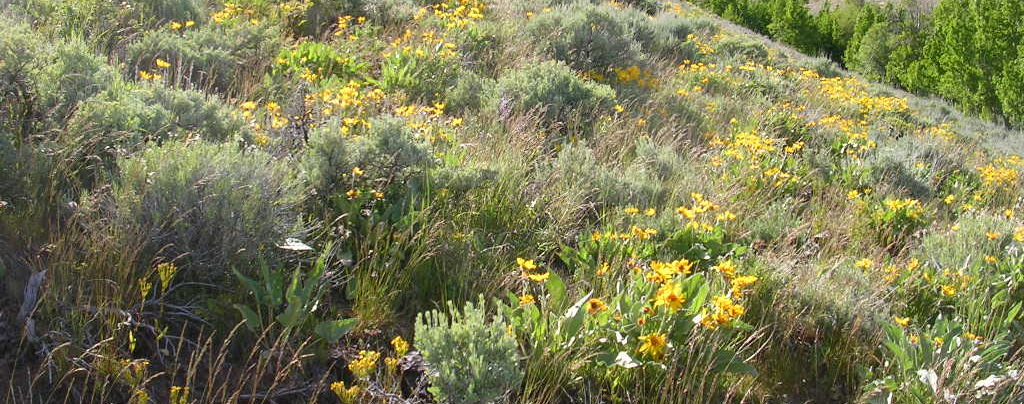Site Preparation - Control of Competition
Site preparation is the most important step to successful establishment. The principal purpose of seedbed preparation is to control weeds and condition the soil for seeding. Most control measures are designed to remove existing vegetation and weed seeds stored in the soil. These procedures are particularly critical in semiarid and arid regions where soil moisture is essential for seedling establishment. Site preparation treatments should be designed to conserve and aid in storage of soil moisture. Less disturbance to the soil is preferred. If the site has been previously farmed, it may be appropriate to choose a moldboard, disk plow or harrow to reduce vegetation. Livestock may also be used to decrease weeds. Contact your County Weed Supervisor or consultant to ask what herbicides may be appropriate. Herbicides can be an effective, necessary, and environmentally sound tool to decrease competition from unwanted vegetation. Follow instructions on the herbicide label. You may choose prescribed fire before applying a leaf foliage herbicide. Chemical can be more effective when applying to new, green plant growth. A cover crop may be grown as an interim step to help reduce weed competition. We recommend 2 years of seedbed preparation to eliminate the unwanted vegetation and the weed seed stored in the soil.
Planting Depth and Seed Coverage
Seed should be in firm contact with the soil to increase moisture availability and decrease chances of drying. When broadcasting, be sure seed is covered by harrowing or raking. Seed should be covered 2.5 to 3 times it's length or 1/4 to 3/8 of an inch. Planting too deep or not covering seed are the major reasons for seeding failure. Seed must have direct contact with the soil.
Seeding Equipment
Most conventional drills place native seed too deep. With proper attention, seeds can be placed at a shallow depth when drill seeding. It is essential that seeds of differing sizes are sown separately to achieve the appropriate depth. Rangeland drills have been developed to control planting depth; with adaptations such as high clearance and heavy duty frames to facilitate seeding with minimum drill breakage. Seed boxes will accommodate seed of various size and shape and maintain an even seed flow. The NRCS, ODFW and OSU Extension may assist in location of a rangeland drill with special native grass seed boxes. Broadcast seed if your site is not appropriate for drill seeding such as rocky or steep terrain. Broadcast a small area or where you may want to protect residual native vegetation from damage. After broadcast seeding, cover seed by harrowing or raking.
Timing of Seeding
Unless seeding under an irrigated situation, late fall, early winter is your best opportunity for success. Fall or winter seeding will provide conditions necessary for native seeds that require a cold, moist period to germinate. Seeds are ready to take advantage of the early spring moist season. Seedlings that emerge early are better able to survive the summer drought period.
Seeding Rate
Sufficient seed should be used to assure good establishment, while being mindful to prevent the waste of seed. Seeding rates may be determined by management (irrigated or dry land), seedbed preparation, planting methods, equipment and seed quality. Usually 10 to 20 pounds per acre for a total mixture is suggested for seeding woodland ranges to a diverse mixture. Native seeds may continue to germinate for years after seeding so be patient. Seeding rates with irrigation and good seedbed preparation may be reduced to 4 to 8 pounds per acre.
Multispecies Mixes vs Single Species
The Seedbank suggests seeding a mixture of species to improve the control of undesirable weeds, ensure the establishment of a desirable stand, promote biodiversity and improve wildlife utilization. However, we recommend seeding grasses the first year, because so often herbicide treatments are required for control of broadleaf weeds. Seed or seedlings of forbs (wildflowers) and shrubs can be established in subsequent years when herbicides are no longer necessary.
Management for Successful Establishment
Fertilization is usually not beneficial in the woodland situation. Annual weeds such as cheat grass will benefit the most from added nutrients. Seed yields in irrigated, production fields will be increased with the addition of nitrogen.
Mulching or hydro-mulching may improve your results. Hydro-mulching is a two-step process. First the seed is sown and then covered with a mulch. Hydro-seeding is not very successful with native seed. In this process, seed and mulch are mixed and often the seed does not establish good contact with the soil. There are many mulching products on the market consisting of paper or straw. Mulch should not be too thick or heavy as to retard the seedling from emerging. In our dry environment mulch can often intercept the precipitation and reduce the availability of moisture to the seed.

